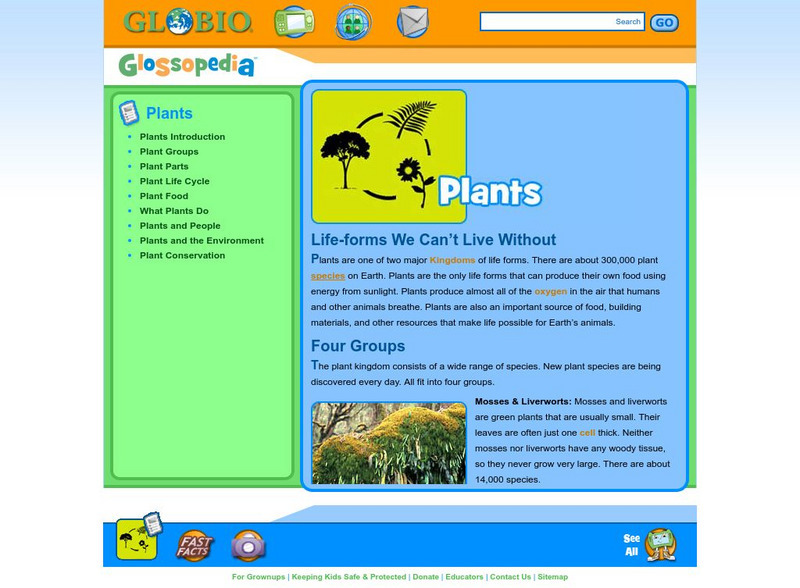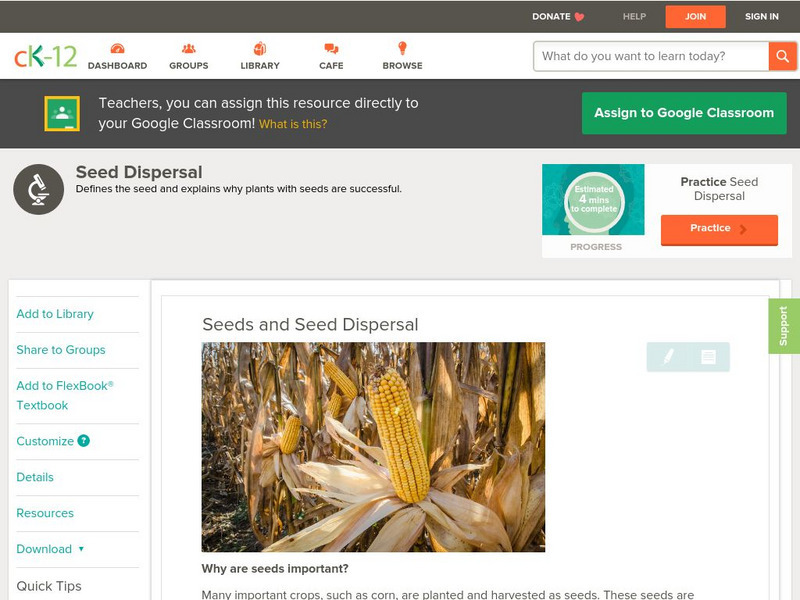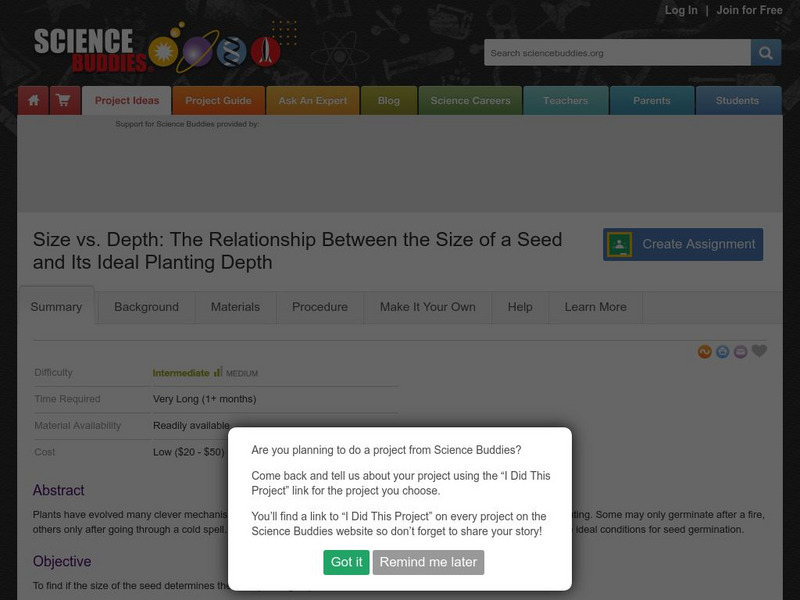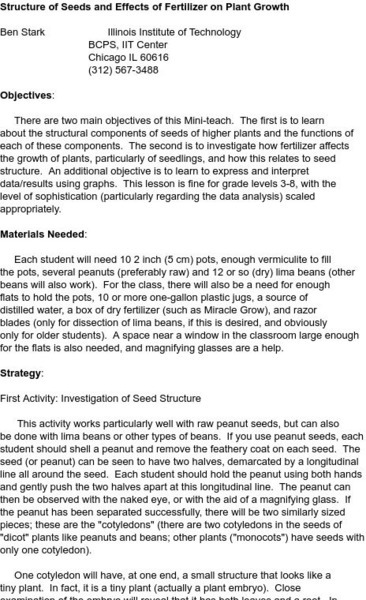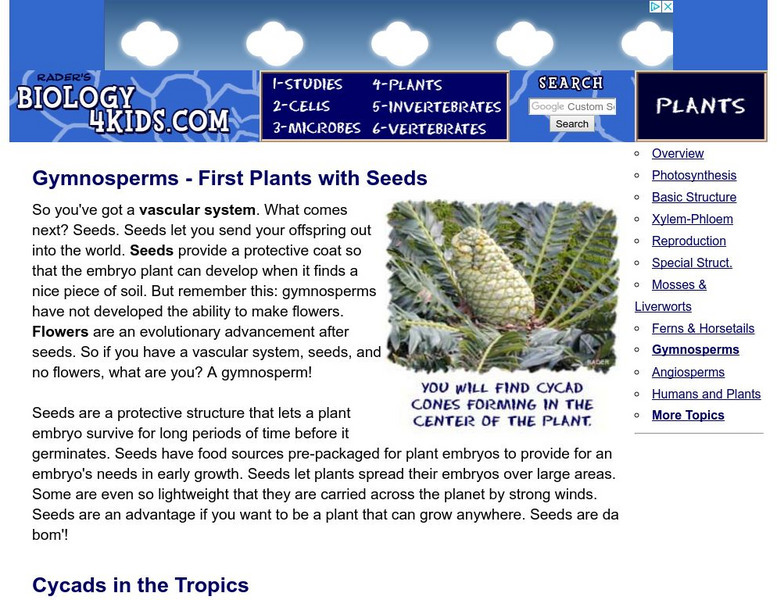Science Buddies
Science Buddies: Gone With the Wind: An Experiment on Seed and Fruit Dispersal
If you have ever made a wish and blown the fluff of a dandelion, you have witnessed how some plants are adapted to spreading their seeds using the wind. The tiny, furry parachute allows the seeds to be picked up by the wind and to be...
Globio
Glossopedia: Plants
Plants are one of the two major Kingdoms of living creatures on the Earth. They are the only beings which produce their own food. Additionally, plants are necessary for animals to live. Plant anatomy, life cycle, reproduction and the...
Utah Education Network
Uen: Seed House
Young scholars will communicate in oral, artistic, written and nonverbal form as they study seeds and their growth. Students will plant seeds, make observations about the seeds' growth, and report their observations to peers .
Children's Museum
The Children's Museum of Indianapolis: Plants Alive: Garden in a Glove Journal
Learners will observe the germination and growth of plants from seeds over the course of several days, and record their observations in a journal.
Unite for Literacy
Unite for Literacy: Plants and Food: Dandelion Days
Read about the life cycle of dandelions from their first appearance in the spring. Includes audio narration in 16 additional languages with text in English.
CK-12 Foundation
Ck 12: Life Science: Seeds and Seed Dispersal
[Free Registration/Login may be required to access all resource tools.] Plants seem to grow wherever they can. How? Plants can't move on their own. So how does a plant start growing in a new area? Learn more about seeds and seed...
CK-12 Foundation
Ck 12: Life Science: Vascular Seedless Plants
[Free Registration/Login may be required to access all resource tools.] Vascular seedless plants have vascular tissue but do not have seeds. Most of the large vascular seedless plants from ancient times are now extinct, but their smaller...
Other
Science and Kids Activities: Pollination and Seed Dispersal
Second graders learn how plants depend on animals to disperse their seeds. Students will learn about ways that animals can disperse seeds. They will design their own model and compare it to the real action of plants and animals. In the...
HotChalk
Hot Chalk: Lesson Plans Page: Kick Off Seed Explorations
This simple lesson plan is designed to have young students become more familiar with fruit seeds by identifying fruit that contains seeds/no seeds, gathering seeds from fruit, explaining the importance of seeds, explaining that seeds...
PBS
Pbs Teachers:a Model of Seed Dispersal
Investigate propagation systems in plants, and explain the ways some animals disperse seeds through their digestive processes. Role-play and map the daily travels of one seed-bearing animal to explore the migration of seeds.
CK-12 Foundation
Ck 12: Life Science: 7.9 Seed Dispersal
Learn how plants disperse their seeds for successful reproduction.
Science Buddies
Science Buddies: Planting Size vs. Depth
Plants have evolved many clever mechanisms to ensure that their seeds will wait for appropriate conditions before sprouting. Some may only germinate after a fire, others only after going through a cold spell. This project explores one...
Science Education Resource Center at Carleton College
Serc: Investigating an Inquiry Approach to Germination Growth in Plants
In this lab, students investigate the effects of a variable on the germination of a small plant. They will compare the growth of their variable to a control then write a lab report to report their findings.
Science Education Resource Center at Carleton College
Serc: Mn Step: Seeds to Plants: How to Grow a Plant
An experiment where first-graders plant seeds and monitor their growth. Prior to planting, they decide on an inquiry question, and how they will find out the answer through the experiment.
Science and Mathematics Initiative for Learning Enhancement (SMILE)
Smile: Structure of Seeds and Effects of Fertilizer on Plants
In this lesson plan, students identify parts of seeds and the effect of fertilizer on their germination and development.
HotChalk
Hot Chalk: Lesson Plans Page: Plants and Animals
In this lesson plan, young students will be able to identify a plant's parts, explain their functions, diagram a plant, and create a mobile to demonstrate their understanding.
Ducksters
Ducksters: Biology for Kids: Flowering Plants
Kids learn about flowering plants in the science of biology including their life-cycle, structures of a flower, fruit, seeds, and pollination.
Biology 4 kids
Biology4 Kids: Angiosperms First Plants With Flowers
This engaging article on angiosperms offers good descriptions and background on these seed bearing plants. Learn about their characteristics and what makes these plants different from gymnosperms.
Virginia Tech
Virginia Tech: Flower and Tree Reproduction
This is the reproduction chapter from an online text, courtesy of the Forest Biology Department of Virginia Tech. Learn about trees, their flowers, and other details of their reproductive cycle.
Texas A&M University
Tamu: Aggie Horticulture: School Gardens
Teachers and students interested in finding information on how to start a garden in their school will find this site very helpful. This site, sponsored by the Department of Horticulture Sciences at Texas A&M University, includes a...
Biology 4 kids
Biology4 Kids: Gymnosperms First Plants With Seeds
This engaging article on gymnosperms offers good descriptions and background on these seed bearing plants. Learn about their characteristics and what makes these plants different from angiosperms.
Alabama Learning Exchange
Alex: Seeds: How They Grow
The students will be collecting, germinating and planting seeds to show the process of plant growth. The students will be recording the information in their science journal. In addition, the students will be observing the water cycle as...
Curated OER
Conifers Use Cones and Seeds Since Flowering Plants Had Not Appeared.
This engaging article on gymnosperms offers good descriptions and background on these seed bearing plants. Learn about their characteristics and what makes these plants different from angiosperms.

